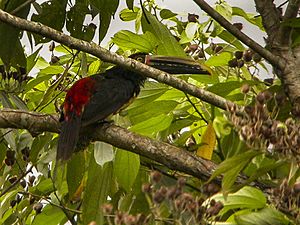Stripe-billed aracari facts for kids
Quick facts for kids Stripe-billed aracari |
|
|---|---|
 |
|
| Conservation status | |
| Scientific classification | |
| Genus: |
Pteroglossus
|
| Species: |
sanguineus
|
| Synonyms | |
|
|
The stripe-billed aracari (Pteroglossus sanguineus) is a colorful bird from the toucan family. It is known for its unique bill with a white stripe. You can find these birds in parts of Colombia, Ecuador, and Panama.
Contents
About the Stripe-billed Aracari
Scientists group animals together based on their features. The International Ornithological Committee (IOC) and BirdLife International think the stripe-billed aracari is its own special kind of bird, or species. However, some other groups, like the American Ornithological Society, see it as a type of collared aracari. This means it's considered a subspecies of the collared aracari.
The stripe-billed aracari is monotypic, which means there are no different types or subspecies of this specific bird.
What Does It Look Like?
The stripe-billed aracari is about 40.5 to 43 cm (15.9 to 16.9 in) long. This includes its long bill, which is about 11.5 to 12.5 cm (4.5 to 4.9 in) in length. It weighs between 175 to 250 g (6.2 to 8.8 oz).
Male and female aracaris look very similar. They have the same colors on their bills and feathers. However, the female's bill is a bit shorter than the male's.
Bill and Feathers
The adult bird's bill has a thin white line at its base. The top part of the bill is yellow with a black stripe along its bottom edge. It also has small black and yellowish-white marks. The bottom part of the bill is black.
Most of the adult's upper body is shiny black. Its lower back, rump, and tail feathers are bright red. The head, throat, and upper chest are a greenish-black color. The lower chest, belly, and under-tail feathers are yellow. The chest often has some red color and a black spot in the middle. A narrow red and black band crosses the upper belly. Their upper legs are brown.
Young aracaris look a bit different from adults. They are much duller in color. Their head and chest are a sooty-black, and their upper body is brownish-olive. The red and yellow parts are paler, and the spots and bands on their belly are not as clear.
Where Do They Live?
The stripe-billed aracari lives in a specific area. You can find them starting from Darién Province in eastern Panama. They live south through western Colombia and into northwestern Ecuador. In Ecuador, they are found in Esmeraldas and Imbabura provinces.
These birds like to live inside and at the edges of forests that stay green all year. They prefer old, untouched forests and also older forests that have grown back. They can also be found in farms that grow coffee, cacao, and fruit.
Behavior and Daily Life
Social Behavior
Stripe-billed aracaris usually travel in groups. These groups can have about six to 15 birds. Sometimes, other types of toucans might join their groups.
They also sleep together in groups. Up to seven aracaris might share a tree hole overnight to rest.
Feeding Habits
The stripe-billed aracari mostly eats fruit. But they also enjoy eating large insects. They might even eat the eggs and baby birds from other nests. Sometimes, they eat other small animals too.
They usually look for food in the middle and top parts of the forest. However, they will also eat fruits found closer to the ground. They get fruit by stretching from a branch, bending over, or even hanging upside down. When they eat large fruits, they often spit out the seeds. These seeds can still grow into new plants.
Reproduction and Life Cycle
The breeding season for the stripe-billed aracari is from December to May. They make their nests in holes in trees. These holes are usually made by large woodpeckers. They can also use natural holes in trees.
They might make the hole bigger if needed. Their nests can be as high as 30 m (98 ft) above the ground. A female usually lays three eggs, but sometimes she can lay up to five. Both parents take turns sitting on the eggs for 16 to 17 days.
The baby birds leave the nest when they are 26 to 30 days old. The parents, and often up to three other adult aracaris, help feed the young birds. When they are very young, they are mostly fed insects.
Vocalization
The stripe-billed aracari has a special call. It is described as a "loud, attention-grabbing, high-pitched, and squeaky 'ksisik' or 'ksiyik!'."
Status and Conservation
The IUCN (International Union for Conservation of Nature) has said that the stripe-billed aracari is a species of "Least Concern." This means they are not currently in danger of disappearing. However, we don't know exactly how many of these birds there are, and their numbers are thought to be going down.
There are no immediate big threats to them right now. Even though they can live in forests that have grown back, they are still very sensitive to deforestation. This means cutting down forests can harm their populations.
See also
 In Spanish: Arasarí de pico rayado para niños
In Spanish: Arasarí de pico rayado para niños


